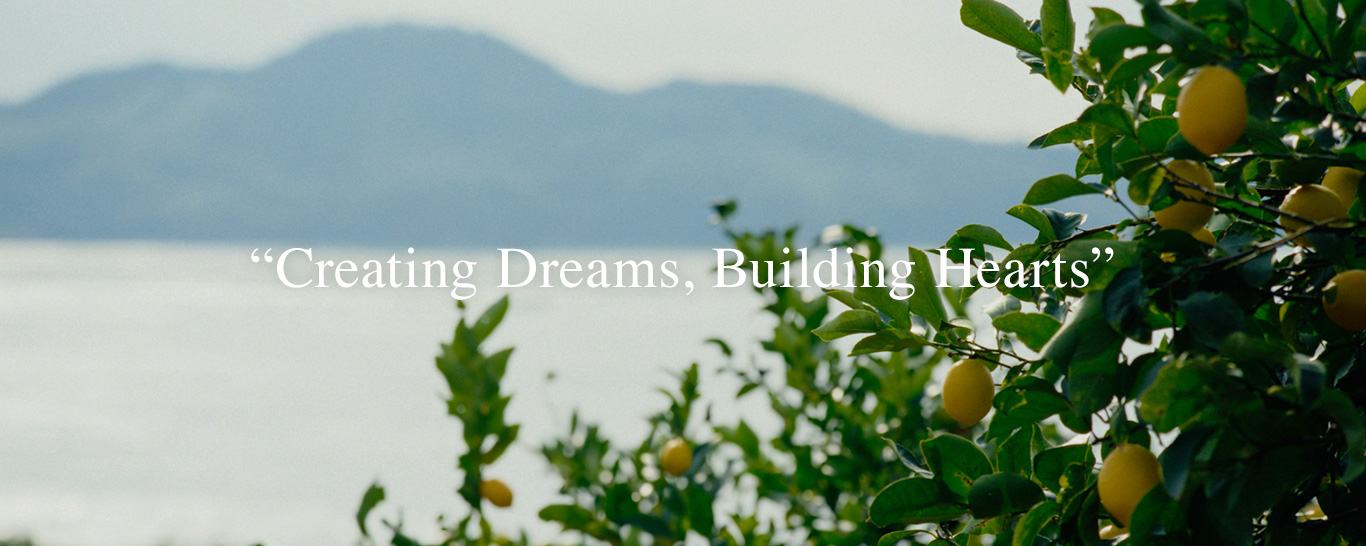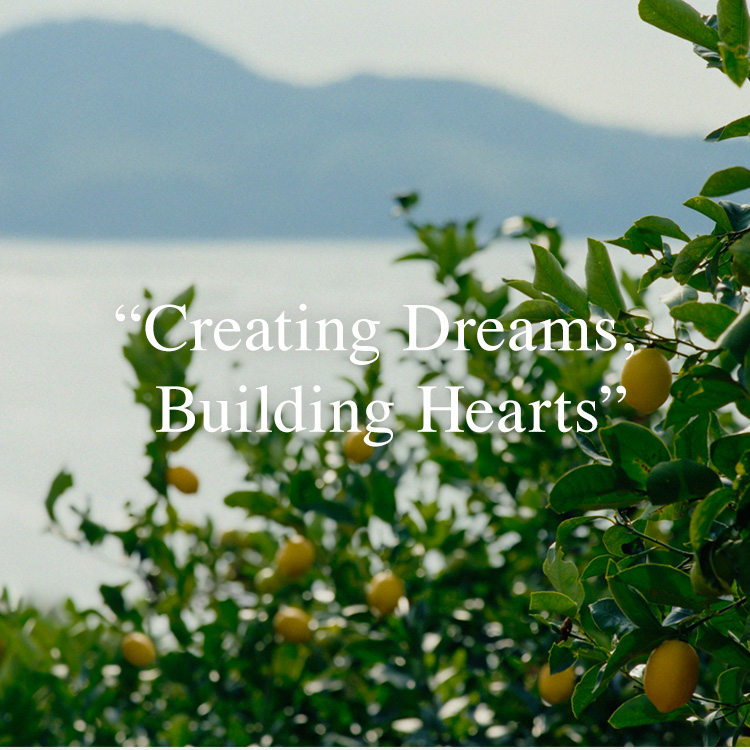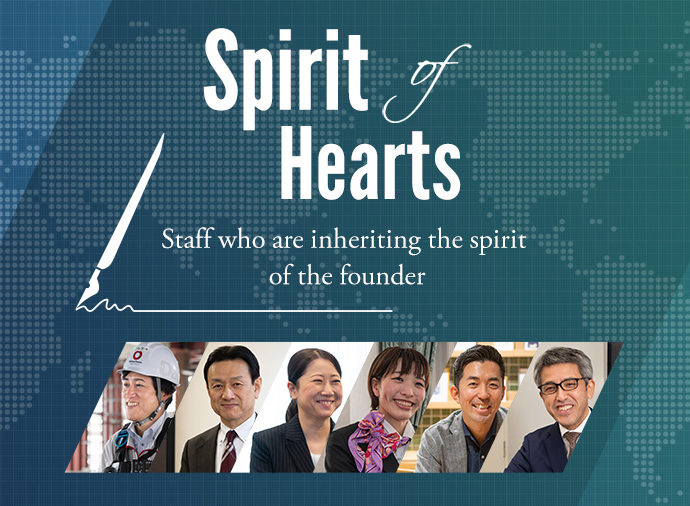


“Creating Dreams, Building Hearts”—Our motto to express Daiwa House Group’s fundamental commitment to creating new value together with our customers, and living symbiotically with society to benefit all its members.
Our business activities bring us into contact with all kinds of people who share the co-creation, symbiotic living ethic, and such encounters make us only more intent on living our commitment.

Different things are important to different people. Some spend time with nature; others, on engaging with tradition. Some prefer to be out in the community; others like staying home with family. The variations are endless. But one thing they share across all these differences is a feeling of belonging from resonance over shared pursuits, and in interacting, touch the lives of others.
These things motivate to make tomorrow a better day. Our fundamental commitment burning in our hearts, we will walk with society toward a future where all share in one another’s joys.
The making of our commercials
Having gotten through the restrictions and hardships of the pandemic, some 100 people of diverse backgrounds gathered to achieve something born of shared sentiment: They gave a choral rendition of Daiwa House’s We Build Hearts theme to express their appreciation for the day and gratitude for having made it through the pandemic.
Watch the commercial(90 seconds)
The island where Setoda—more precisely, the town of Setoda in the city of Onomichi, Hiroshima—is know as “the island of lemons” for the fruit raised there. And the island is full of people who also know how to cultivate joy. Lemons—with their aroma, flavor, and color—are of potential for widening the Creating Dreams, Building Hearts circle of friends!
Watch the commercial90-second TV commercial
Kesennuma, a city in Miyagi Prefecture that lives in harmony with the sea. It’s the fishing industry, or perhaps the positive, cheerful people who live there that attract the nation’s youth. Indeed, the open hearts of the city’s residents warmly welcome people from other places. The inhabitants of Kesennuma share the same basic stance as Daiwa House Group, that being “Creating Dreams, Building Hearts.” This expresses our desire to connect with the joy of living on this land through its people, transcending generations and charting a course to the future.
Click here for the TV commercialStory of “Creating Dreams,Building Hearts.”
The Joys of Life version
Lemon Bonds version
The “Each Morning in Kesennuma” Series
The Joys of Life version
There are times when an audience and the members of an orchestra numbering a hundred or more performers come together as one, all resonating with one another through the music; this, too, is one form Creating Dreams, Building Hearts can take. For the filming of the Joys of Life commercial, Daiwa House employees, members of the community, kids, and the musicians all joined together under one roof to create a unique work—making it quite an experience for all participants! The applause and praise of audiences in our hearts, we’re ready to go on making world-changing music!
1/5

The Joys of Life concert with the Osaka Symphony Orchestra
The Joys of Life version
You couldn’t go anywhere. You couldn’t meet with friends. Amid the pandemic, everyone was made aware of how wonderful their routine everyday was. With all the restrictions now a thing of the past, over 100 musicians and singers gave a concert embodying Creating Dreams, Building Hearts! We believe this desire to co-create and live in harmony together, will carry us to a future where all share in one another’s joys.
2/5

Daiwa House Group employees
Lemon Bonds version
They’re adorable in name and shape! Lemons project cheerfulness and a bright, refreshing character—just like I’d like to be, and what I wish for the people of Setoda. And the area’s lemons help form bonds between the locals and people who’ve moved here, among the locals themselves, and further among everyone who lives here and people who come to visit or do business. And the area’s natural abundance gives its lemons this wonderful ability. That’s why I want to keep on relating their stories—conveying not just glimpses of their juice and fragrance, but ones that tell of the land and the people here, as well as describe how the fruit transform from dark green into bright yellow as they grow.
3/5

Yoko Nagamitsu
Hunter and culinary consultant on satoyama cuisine
Lemon Bonds version
I’ve loved lemons ever since I was little. A sudden desire to try raising them myself led to my discovery of Setoda and moving here. Having decided to make lemons my living, I’ve connected with the locality and its people, so now there’s nothing else left but for me to explore what I can achieve with lemons. Sometimes human intervention helps to better sustain nature’s abundance. In Setoda, people contemplate the future of the island and its lemons together, and they support one another in endeavoring to achieve it. I want to go beyond doing just what I like here, going the extra mile to help face challenges so as many people as possible can appreciate the value of the lemons we raise here.
4/5

Lemon farm apprentice
Akemi Saito
Director at AKEMILEMON
Lemon Bonds version
The first time I came to Setoda, everything about the island felt refreshingly novel. Of course I felt that way about the lemons, but the whole island struck me as a treasure trove! When people all move to one place, it means there are other places that get under-populated. To keep that from happening here, I want to see the locals become able to maintain the locality on their own. It has a mild climate, and people are able to do things in their own time and at their own pace under the bright warm sun. I’d like to see future generations be able to live this way too, and to that I’m doing what I can through my kind of confections.
5/5

Nami Harayama
Pâtissier
The “Each Morning in Kesennuma” Series
I’ve always liked fishing, and wanted to live near the sea, so being a fisherman was the only way to go! With that in mind, I moved to Kesennuma to give becoming a fisherman a try. In my one-year trial period, I took notice of the garbage problem associated with fishing boats, and issues with unutilized catch. That’s what started me off working with fixed-net fishing, which is a proactive approach to dealing with garbage and other problems. The best feeling in the world is eating breakfast on board a boat. Every day I eat rice steamed right on board together with freshly caught fish, and every day it’s delicious. Things like the fish and how good they taste, which by themselves can’t be conveyed by the style of eating and that appeal, should, I think, have their value expressed by the one who actually made the catch, so I’ve been thinking that I’d like to open a shop or a restaurant in the future. My interactions with a variety of people have increased since I came to Kesennuma. I feel that my connection with this place is growing little by little.
6/8

Fixed-net fisherman
Naoki Ohata
The “Each Morning in Kesennuma” Series
I’m from Tokyo, but when the Great East Japan Earthquake hit, I went to do volunteer work, staying at “Tsunakan,” a guest house on the Karakuwa Peninsula while I commuted to Kesennuma. As a volunteer, I met professional fisherman who would put their life on the line for their boats. I was so impressed with their rugged style and the way they lived their lives, that after graduating from university I moved to Kesennuma and joined the Tsubaki Association, a group that promotes Kesennuma. To support the local fishermen, we established the Tsurukame Shokudo, a cafeteria, and the public bath, Tsurukame no Yu. In the spirit of being “the most supportive town for fishermen in all of Japan,” we work to find solutions to their troubles. Our main efforts go to increasing the number of fishermen, and we also serve as someone to talk to for young fishermen. My position is to cheer on fishermen, and I’m someone who delights in seeing their smiling faces. I want this to be a town where fishermen, who live life with such cool, will be happy to live in. When they board their boat, I hope that they will forget their worries about the little things and become even stronger.
7/8

Tsubaki Association member
Ema Negishi
The “Each Morning in Kesennuma” Series
My hometown is Kuji City, Iwate Prefecture, but I married a fisherman who runs an oyster farming business in Karakuwa. Currently, I’m the proprietor of “Tsunakan,” a guest house on the Karakuwa Peninsula. We started Tsunakan after the Great East Japan Earthquake, when we opened our home to volunteers as a place to stay. After the earthquake, people from Hiroshima came and built a raft for oyster farming for us, which really made me feel that, on account of the earthquake, that outsiders would be the ones to lend a helping hand. Even now, I think of that “light brought by others.”
8/8

The proprietor of guest house Tsunakan
Kazuyo Sugano
The Joys of Life version
There are times when an audience and the members of an orchestra numbering a hundred or more performers come together as one, all resonating with one another through the music; this, too, is one form Creating Dreams, Building Hearts can take. For the filming of the Joys of Life commercial, Daiwa House employees, members of the community, kids, and the musicians all joined together under one roof to create a unique work—making it quite an experience for all participants! The applause and praise of audiences in our hearts, we’re ready to go on making world-changing music!
1/5

The Joys of Life concert with the Osaka Symphony Orchestra
The Joys of Life version
You couldn’t go anywhere. You couldn’t meet with friends. Amid the pandemic, everyone was made aware of how wonderful their routine everyday was. With all the restrictions now a thing of the past, over 100 musicians and singers gave a concert embodying Creating Dreams, Building Hearts! We believe this desire to co-create and live in harmony together, will carry us to a future where all share in one another’s joys.
2/5

Daiwa House Group employees
Lemon Bonds version
They’re adorable in name and shape! Lemons project cheerfulness and a bright, refreshing character—just like I’d like to be, and what I wish for the people of Setoda. And the area’s lemons help form bonds between the locals and people who’ve moved here, among the locals themselves, and further among everyone who lives here and people who come to visit or do business. And the area’s natural abundance gives its lemons this wonderful ability. That’s why I want to keep on relating their stories—conveying not just glimpses of their juice and fragrance, but ones that tell of the land and the people here, as well as describe how the fruit transform from dark green into bright yellow as they grow.
3/5

Yoko Nagamitsu
Hunter and culinary consultant on satoyama cuisine
Lemon Bonds version
I’ve loved lemons ever since I was little. A sudden desire to try raising them myself led to my discovery of Setoda and moving here. Having decided to make lemons my living, I’ve connected with the locality and its people, so now there’s nothing else left but for me to explore what I can achieve with lemons. Sometimes human intervention helps to better sustain nature’s abundance. In Setoda, people contemplate the future of the island and its lemons together, and they support one another in endeavoring to achieve it. I want to go beyond doing just what I like here, going the extra mile to help face challenges so as many people as possible can appreciate the value of the lemons we raise here.
4/5

Lemon farm apprentice
Akemi Saito
Director at AKEMILEMON
Lemon Bonds version
The first time I came to Setoda, everything about the island felt refreshingly novel. Of course I felt that way about the lemons, but the whole island struck me as a treasure trove! When people all move to one place, it means there are other places that get under-populated. To keep that from happening here, I want to see the locals become able to maintain the locality on their own. It has a mild climate, and people are able to do things in their own time and at their own pace under the bright warm sun. I’d like to see future generations be able to live this way too, and to that I’m doing what I can through my kind of confections.
5/5

Nami Harayama
Pâtissier
The “Each Morning in Kesennuma” Series
I’ve always liked fishing, and wanted to live near the sea, so being a fisherman was the only way to go! With that in mind, I moved to Kesennuma to give becoming a fisherman a try. In my one-year trial period, I took notice of the garbage problem associated with fishing boats, and issues with unutilized catch. That’s what started me off working with fixed-net fishing, which is a proactive approach to dealing with garbage and other problems. The best feeling in the world is eating breakfast on board a boat. Every day I eat rice steamed right on board together with freshly caught fish, and every day it’s delicious. Things like the fish and how good they taste, which by themselves can’t be conveyed by the style of eating and that appeal, should, I think, have their value expressed by the one who actually made the catch, so I’ve been thinking that I’d like to open a shop or a restaurant in the future. My interactions with a variety of people have increased since I came to Kesennuma. I feel that my connection with this place is growing little by little.
6/8

Fixed-net fisherman
Naoki Ohata
The “Each Morning in Kesennuma” Series
I’m from Tokyo, but when the Great East Japan Earthquake hit, I went to do volunteer work, staying at “Tsunakan,” a guest house on the Karakuwa Peninsula while I commuted to Kesennuma. As a volunteer, I met professional fisherman who would put their life on the line for their boats. I was so impressed with their rugged style and the way they lived their lives, that after graduating from university I moved to Kesennuma and joined the Tsubaki Association, a group that promotes Kesennuma. To support the local fishermen, we established the Tsurukame Shokudo, a cafeteria, and the public bath, Tsurukame no Yu. In the spirit of being “the most supportive town for fishermen in all of Japan,” we work to find solutions to their troubles. Our main efforts go to increasing the number of fishermen, and we also serve as someone to talk to for young fishermen. My position is to cheer on fishermen, and I’m someone who delights in seeing their smiling faces. I want this to be a town where fishermen, who live life with such cool, will be happy to live in. When they board their boat, I hope that they will forget their worries about the little things and become even stronger.
7/8

Tsubaki Association member
Ema Negishi
The “Each Morning in Kesennuma” Series
My hometown is Kuji City, Iwate Prefecture, but I married a fisherman who runs an oyster farming business in Karakuwa. Currently, I’m the proprietor of “Tsunakan,” a guest house on the Karakuwa Peninsula. We started Tsunakan after the Great East Japan Earthquake, when we opened our home to volunteers as a place to stay. After the earthquake, people from Hiroshima came and built a raft for oyster farming for us, which really made me feel that, on account of the earthquake, that outsiders would be the ones to lend a helping hand. Even now, I think of that “light brought by others.”
8/8

The proprietor of guest house Tsunakan
Kazuyo Sugano
Drawing on the Endless Heart Group symbol, this piece expresses the continuing bond between Daiwa House and our customers as well as our solidarity within the Group. While it is played in a variety of different ways with different instruments and rhythm arrangements, the core melody remains the same. This is an expression of our unchanging heart.

“Creating Dreams, Building Hearts” is the basis of our unchanging heart.
Endless Heart
These are stories of the challenges faced by employees who have inherited our founder's vision. In these stories, which embody the concept of Creating Dreams, Building Hearts, we introduce the situations behind the scenes of our projects, as well as the thoughts of employees working hard on our building sites.
Spirit of Hearts